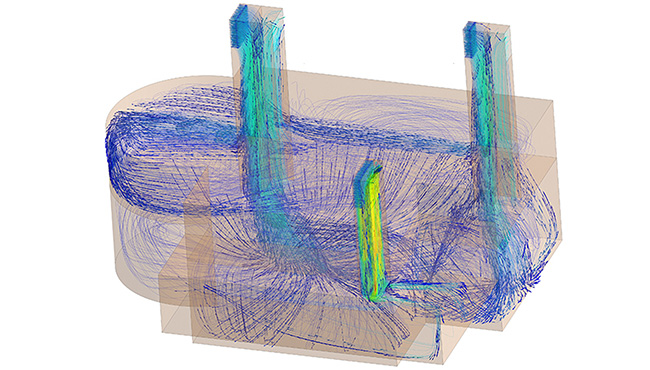The Role of CFD in HVAC System Optimization
As buildings become larger and more complex, ensuring efficient building ventilation is a growing challenge. Traditional HVAC design methods often rely on simplified calculations that fail to capture real-world airflow behaviors. This leads to poor air circulation, thermal discomfort, and increased energy costs. CFD Ventilation Simulation is revolutionizing the way engineers approach HVAC CFD Analysis, providing high-precision insights into air distribution, thermal behavior, and pollutant dispersion inside buildings.
By using CFD for buildings, engineers can predict air stagnation zones, optimize ventilation efficiency, and create HVAC systems that deliver uniform temperature distribution while minimizing energy waste. This advanced approach ensures compliance with ASHRAE standards and enhances indoor comfort, making it essential for modern ventilation efficiency simulation in commercial and industrial spaces.
Scientific Principles of CFD Ventilation Simulation
Building Ventilation CFD relies on solving the Navier-Stokes equations, modeling how air moves through ductwork, rooms, and occupied spaces. Different CFD HVAC Simulation techniques, such as RANS (Reynolds-Averaged Navier-Stokes), LES (Large Eddy Simulation), and DES (Detached Eddy Simulation), allow engineers to analyze complex turbulence effects that impact ventilation performance.
Recent studies have shown that integrating CFD for buildings can enhance airflow efficiency by up to 30%, significantly reducing cooling and heating costs. Key parameters analyzed through HVAC CFD Analysis include:
- Airflow distribution: Simulating the effectiveness of different ventilation strategies.
- Temperature gradients: Identifying thermal stratification and correcting uneven heating/cooling.
- Air exchange rates: Ensuring compliance with ASHRAE ventilation efficiency standards.
- Contaminant dispersion: Evaluating pollutant transport and improving indoor air quality.
With these capabilities, CFD Simulation Services offer a data-driven approach to designing high-performance HVAC systems that deliver optimal airflow management in buildings.
Real-World Applications of CFD in Ventilation Design
1. High-Performance Commercial Buildings
Research studies on office ventilation efficiency showed that CFD-based HVAC optimization can reduce the energy use by 20% while improving occupant comfort. By simulating airflow pathways, engineers optimized ventilation layouts, reducing hot and cold spots and preventing stagnant air zones.
2. Industrial and Cleanroom Environments
In manufacturing plants and pharmaceutical cleanrooms, maintaining precise airflow control is critical for contamination prevention. A CFD-driven airflow optimization study by Huang et al. (2020) found that modifying air inlet configurations improved ventilation efficiency , significantly reducing airborne particle concentrations.
3. Hospital Ventilation and Infection Control
With increasing concerns about airborne pathogens, CFD HVAC Simulation has been widely adopted in healthcare settings. Research on hospital air quality demonstrated that Building Ventilation CFD could help optimize air circulation in patient wards, reducing the spread of infectious aerosols .
The Future of HVAC Design: AI and Smart CFD Simulation
With the rise of AI-driven CFD models, engineers can now perform real-time ventilation adjustments based on occupancy levels and air quality monitoring. Machine learning-integrated CFD for buildings enables:
- Predictive HVAC control for dynamic indoor airflow optimization.
- IoT-driven HVAC adjustments for energy efficiency and cost reduction.
- Automated airflow balancing to maintain optimal ventilation efficiency.
Advancements in CFD Simulation Services are setting the foundation for next-generation smart buildings, where HVAC systems dynamically adapt to environmental conditions, minimizing energy waste while maximizing air quality and thermal comfort.
Learn more about how our product design services can bring smarter, more efficient solutions to your engineering challenges.
Why HVAC Professionals Should Invest in CFD Analysis
For HVAC engineers, building designers, and facility managers, adopting CFD Ventilation Simulation is no longer optional—it’s essential. With HVAC CFD Analysis, professionals can reduce energy costs, improve air distribution, and create healthier indoor environments.
If you’re involved in building ventilation design, consider integrating CFD Simulation Services into your workflow to optimize HVAC efficiency and gain a competitive advantage in sustainable building solutions. Contact us to explore how CFD consulting for HVAC can transform your next project.
